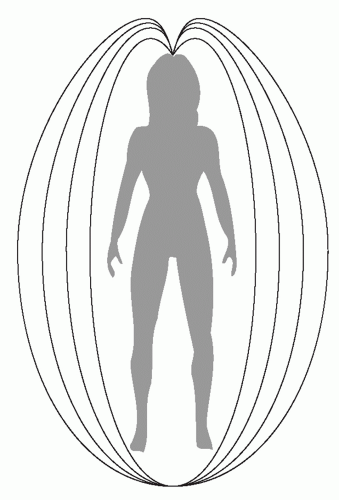|
Name and describe three major energetic structures.
Discuss one view of chakras.
Describe electromagnetic induction and entrainment and how they might operate in energy healing.
Discuss the role of intention in creating healing space.
Discuss one problem in energy healing research.
Find an expert healer and determine what makes this person an expert healer. What made you decide this person was an expert? If this person is a nurse practicing energy healing, how does she integrate them?
Use the intuitive exercises in the chapter to explore auras, chakras, and meridians.
Experience a laying on of hands modality.
Explore the effect of your presence.
Experience an essential oil, flower essence, and/or homeopathic preparation that might be useful for you.
Experience the effects of music you do not like. Stand a few feet away from it as you listen to it for a few minutes. Gradually, over several weeks, move closer.
Synchronization is recognized in pendulum clocks, planets, music, an organism adjusting to the light/dark cycle, brain waves, social groups, and more.
biological and psychological health of the organism; if it is not flowing properly, you hurt. You hurt physically, you hurt emotionally, and you hurt spiritually. Many cultures have developed methods to heal that flow, including the Chinese ChiKung (qi gong), the Hawaiian Huna, Tibetan meditations, Hindu yoga, and Native American drumming, among others. The energy is called by many names, including chi, ki, qi, mana, prana, and etheric; modalities using these energies are classified as “laying on of hands,” “biofield therapy,” and “subtle energy healing.” Other forms of subtle energy healing use light, sound, aromas, homeopathy, and flower essences.
An electromagnetic field gives us power to do work we could not do by ourselves. It can lift cars in junk yards and is used to create the motors we use in many aspects of life.
One way to create an electromagnetic field is to place current carrying wires close together. When electricity is flowing, it creates an electromagnetic field surrounding the flow. When current-carrying wires are close to each other, their electromagnetic fields combine and the result is a stronger field. Engineers do this by tightly coiling an electrical wire around some kind of core, such as an iron rod, creating the effect of a series of adjacent wires even though it is one long electric wire.
The amount of power created is determined by the number of times the electric wire is wound around the core, meaning the more adjacent electric currents, the more work that can be done with the same amount of electricity.
Although it is not exactly the same, you can visualize an electromagnetic field by sprinkling iron filings randomly on a piece of paper. Place a bar magnet in the middle of the iron filings and notice how they instantly move to take a more or less oval shape around the magnet. (You may need to tap the piece of paper to help the iron filings move a bit.) This oval shape demonstrates the magnetic field emitted by the magnet. If you have the equipment, coil an electric wire around an iron core, sprinkle iron filings next to it, and turn on the electricity. You will see that the iron filings arrange themselves in a pattern around the wire/iron core device. More filings are closer to the core than farther
away, suggesting that the field is stronger closer to the core than it is farther away.
TABLE 33-1 Similarities Between an Electromagnetic Field and the Human Aura | ||||||||||||||||
|---|---|---|---|---|---|---|---|---|---|---|---|---|---|---|---|---|
| ||||||||||||||||
Human blood contains hemoglobin, which contains iron. The vascular system of heart, arteries, veins, and capillaries results in an intricate tubular iron core that is surrounded by or, more accurately, intertwined by three electrical fields: neurons, meridians, and the minute electrical pulses of each single cell. Because of the electrical flow around the body’s iron core, the body must put out an electromagnetic field.
Medical science uses the magnetic nature of the human body for diagnoses. The magnetocardiogram (MCG) measures the heart’s magnetic field, and the magnetoencephalogram (MEG) assesses the head’s magnetic field. The well-known
MRI (magnetic resonance imaging) produces pictures of the body at the cellular level.10
People who are anemic have too little iron in their bloodstreams and are weak. Perhaps this is because their iron core is diminished, and, even with an unchanged electrical field, they emit less electromagnetic power and have less power to do work.
If you choose to sense a person’s electromagnetic field, notice that it is easier to sense closer to the person than farther away. You may be able to sense a layer-like pattern with different characteristics at different distances from the body. Some areas are thick, others moist, some bumpy; each is likely to be different from the next.
hands, move it up through the joints in the arms and legs, to the hips and shoulders, and to the central chakra chain. In the major-minor chakra scheme, there are more than 360 chakras in the human body, which enables a person to gather and process the minute details of every experience.15 Very little crucial data are likely to escape detection by such a finely crafted system.
TABLE 33-2 Traditional Chakra Locations, Associated Organs and Nervous Structures, and Attributes | |||||||||||||||||||||||||||||||||||||||||||||||||||||||||||||||
|---|---|---|---|---|---|---|---|---|---|---|---|---|---|---|---|---|---|---|---|---|---|---|---|---|---|---|---|---|---|---|---|---|---|---|---|---|---|---|---|---|---|---|---|---|---|---|---|---|---|---|---|---|---|---|---|---|---|---|---|---|---|---|---|
| |||||||||||||||||||||||||||||||||||||||||||||||||||||||||||||||
TABLE 33-3 Four Perspectives of Chakra Functions | |||||||||||||||||||||||||||||||||||||||||
|---|---|---|---|---|---|---|---|---|---|---|---|---|---|---|---|---|---|---|---|---|---|---|---|---|---|---|---|---|---|---|---|---|---|---|---|---|---|---|---|---|---|
| |||||||||||||||||||||||||||||||||||||||||
the fifth chakra from 19 to 25 years. Insight, the abstract and complex function of the sixth chakra, matures between 25 and 35 years of age. The crown chakra, which includes the ability to have a mature relationship with the Divine, matures after age 35 (see Table 33-4).
Stay updated, free articles. Join our Telegram channel

Full access? Get Clinical Tree




